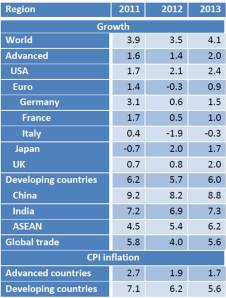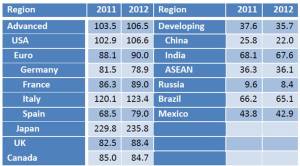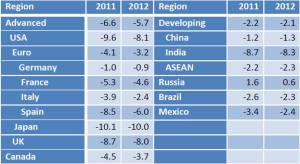The time I invested since my student days, to Private Corporate Sector, and presently working with a public sector autonomous body, I got opportunity to interact with good number of individuals who either were aspiring to get into a B-School so that they can land up smoothly and get absorbed in the vacant Human Resource Positions/ existing Manpower Requirements of Corporate (Private or Public) Sector.
I met one more category of individuals [relevant to this write up], who were pursuing their Post Graduate Program at some institution or Master’s Degree Program at some University to earn their PG Diploma in Business Management or Master of Business Administration Degree.
Since at this level they happen to be very new, it is not expected of them to be expert enough to understand the complexity of Industrial and Corporate Sector. Often, I noticed that at this stage, they thought that Business Administration as probably something very near to (if, not synonymous to) knowledge domains called as Economics or Commerce.
The other component that they look as business is Stock Market Index [Sensex or NIFTY], as they often see numerous articles discussing the business scenario or economic scenario and relating these to Stock Market Index in or the other context. Specially, since 2008 onwards there has been so much volatility and lack of stability in markets that now they often make headlines in Political News Papers too.
I found them, often very curious, to learn what Stock Market Index is, how it is created, why it is there, how is it a reflection of economic scenario and many more questions of the similar kind.
The problem is that majority of such individuals, even after having earned their degree or diploma sometimes, are not aware of it. There is no use deliberating on issue that why it is so, as that is not the subject of this deliberation. So coming directly to the topic, and that is to explain the heads mentioned below:
1. History of BSE
2. Calculation Methodology
3. Scrip Selection Criteria
4. Free Float Methodology
5. Definition of Free Float
6. Major Advantages of Free Float
7. History of NIFTY
8. Calculation Methodology
9. Scrip Selection Criteria
The same follows here onwards:
HISTORY OF BSE SENSEX
SENSEX, first compiled in 1986, was calculated on a ‘Market Capitalization-Weighted’ methodology of 30 component stocks representing large, well-established and financially sound companies across key sectors. The base year of SENSEX was taken as 1978-79. SENSEX today is widely reported in both domestic and international markets through print as well as electronic media. It is scientifically designed and is based on globally accepted construction and review methodology. Since September 1, 2003, SENSEX is being calculated on a free-float market capitalization methodology. The ‘free-float market capitalization-weighted’ methodology is a widely followed index construction methodology on which majority of global equity indices are based; all major index providers like MSCI, FTSE, STOXX, S&P and Dow Jones use the free-float methodology.
The growth of the equity market in India has been phenomenal in the present decade. Right from early nineties, the stock market witnessed heightened activity in terms of various bull and bear runs. In the late nineties, the Indian market witnessed a huge frenzy in the ‘TMT’ sectors. More recently, real estate caught the fancy of the investors. SENSEX has captured all these happenings in the most judicious manner. One can identify the booms and busts of the Indian equity market through SENSEX. As the oldest index in the country, it provides the time series data over a fairly long period of time (from 1979 onwards). Small wonder, the SENSEX has become one of the most prominent brands in the country.
CALCULATION METHODOLOGY
SENSEX is calculated using the ‘Free-float Market Capitalization’ methodology, wherein, the level of index at any point of time reflects the free-float market value of 30 component stocks relative to a base period. The market capitalization of a company is determined by multiplying the price of its stock by the number of shares issued by the company. This market capitalization is further multiplied by the free-float factor to determine the free-float market capitalization.
The base period of SENSEX is 1978-79 and the base value is 100 index points. This is often indicated by the notation 1978-79=100. The calculation of SENSEX involves dividing the free-float market capitalization of 30 companies in the Index by a number called the Index Divisor. The Divisor is the only link to the original base period value of the SENSEX. It keeps the Index comparable over time and is the adjustment point for all Index adjustments arising out of corporate actions, replacement of scrips etc. During market hours, prices of the index scrips, at which latest trades are executed, are used by the trading system to calculate SENSEX on a continuous basis.
SCRIP SELECTION CRITERIA
The general guidelines for selection of constituents in SENSEX are as follows:
- Equities of companies listed on Bombay Stock Exchange Ltd. (excluding companies classified in Z group, listed mutual funds, scrip suspended on the last day of the month prior to review date, scrips objected by the Surveillance department of the Exchange and those that are traded under permitted category) shall be considered eligible.
- Listing History: The scrip should have a listing history of at least three months at BSE. An exception may be granted to one month, if the average free-float market capitalization of a newly listed company ranks in the top 10 of all companies listed at BSE. In the event that a company is listed on account of a merger / demerger / amalgamation, a minimum listing history is not required.
- The scrip should have been traded on each and every trading day in the last three months at BSE. Exceptions can be made for extreme reasons like scrip suspension etc.
- Companies that have reported revenue in the latest four quarters from its core activity are considered eligible.
- From the list of constituents selected through Steps 1-4, the top 75 companies based on free-float market capitalisation (avg. 3 months) are selected as well as any additional companies that are in the top 75 based on full market capitalization (avg. 3 months).
- The filtered list of constituents selected through Step 5 (which can be greater than 75 companies) is then ranked on absolute turnover (avg. 3 months).
- Any company in the filtered, sorted list created in Step 6 that has Cumulative Turnover of >98%, are excluded, so long as the remaining list has more than 30 scrips.
- The filtered list calculated in Step 7 is then sorted by free float market capitalization. Any company having a weight within this filtered constituent list of <0.50% shall be excluded.
- All remaining companies will be sorted on sector and sub-sorted in the descending order of rank on free-float market capitalization.
- Industry/Sector Representation: Scrip selection will generally attempt to maintain index sectoral weights that are broadly in-line with the overall market.
- Track Record: In the opinion of the BSE Index Committee, all companies included within the SENSEX should have an acceptable track record.
UNDERSTANDING FREE FLOAT METHODOLOGY
Free-float methodology refers to an index construction methodology that takes into consideration only the free-float market capitalization of a company for the purpose of index calculation and assigning weight to stocks in the index. Free-float market capitalization takes into consideration only those shares issued by the company that are readily available for trading in the market. It generally excludes promoters’ holding, government holding, strategic holding and other locked-in shares that will not come to the market for trading in the normal course. In other words, the market capitalization of each company in a free-float index is reduced to the extent of its readily available shares in the market.
Subsequently all BSE indices with the exception of BSE-PSU index have adopted the free-float methodology.
DEFINITION OF FREE FLOAT
Shareholding of investors that would not, in the normal course come into the open market for trading are treated as ‘Controlling/ Strategic Holdings’ and hence not included in free-float. Specifically, the following categories of holding are generally excluded from the definition of Free-float:
- Shares held by founders/directors/ acquirers which has control element
- Shares held by persons/ bodies with ‘Controlling Interest’
- Shares held by Government as promoter/acquirer
- Holdings through the FDI Route
- Strategic stakes by private corporate bodies/ individuals
- Equity held by associate/group companies (cross-holdings)
- Equity held by Employee Welfare Trusts
- Locked-in shares and shares which would not be sold in the open market in normal course.
MAJOR ADVANTAGES OF FREE FLOAT METHODOLOGY
- A Free-float index reflects the market trends more rationally as it takes into consideration only those shares that are available for trading in the market.
- Free-float Methodology makes the index more broad-based by reducing the concentration of top few companies in Index.
- A Free-float index aids both active and passive investing styles. It aids active managers by enabling them to benchmark their fund returns vis-a -vis an investible index. This enables an apple-to-apple comparison thereby facilitating better evaluation of performance of active managers. Being a perfectly replicable portfolio of stocks, a Free-float adjusted index is best suited for the passive managers as it enables them to track the index with the least tracking error.
- Free-float Methodology improves index flexibility in terms of including any stock from the universe of listed stocks. This improves market coverage and sector coverage of the index. For example, under a Full-market capitalization methodology, companies with large market capitalization and low free-float cannot generally be included in the Index because they tend to distort the index by having an undue influence on the index movement. However, under the Free-float Methodology, since only the free-float market capitalization of each company is considered for index calculation, it becomes possible to include such closely-held companies in the index while at the same time preventing their undue influence on the index movement.
- Globally, the Free-float Methodology of index construction is considered to be an industry best practice and all major index providers like MSCI, FTSE, S&P and STOXX have adopted the same. MSCI, a leading global index provider, shifted all its indices to the Free-float Methodology in 2002. The MSCI India Standard Index, which is followed by Foreign Institutional Investors (FIIs) to track Indian equities, is also based on the Free-float Methodology. NASDAQ-100, the underlying index to the famous Exchange Traded Fund (ETF) – QQQ is based on the Free-float Methodology.
HISTORY OF NIFTY
S&P CNX Nifty is a well diversified 50 stock index accounting for 21 sectors of the economy. It is used for a variety of purposes such as benchmarking fund portfolios, index based derivatives and index funds.
S&P CNX Nifty is owned and managed by India Index Services and Products Ltd. (IISL), which is a joint venture between NSE and CRISIL. IISL is India’s first specialised company focused upon the index as a core product. IISL has a Marketing and Licensing Agreement with Standard & Poor’s (S&P), who are world leaders in index services.
- Traded value for the last six months of all Nifty stocks is approximately 44.89% of the traded value of all stocks on the NSE
- Nifty stocks represent about 58.64% of the total market capitalization as on March 31, 2008.
- Impact cost of the S&P CNX Nifty for a portfolio size of Rs.2 crore is 0.15%
- S&P CNX Nifty is professionally maintained and is ideal for derivatives trading
CALCULATION METHODOLOGY
S&P CNX Nifty is computed using market capitalization weighted method, wherein the level of the index reflects the total market value of all the stocks in the index relative to a particular base period. The method also takes into account constituent changes in the index and importantly corporate actions such as stock splits, rights, etc without affecting the index value.
SCRIP SELECTION CRITERIA
The constituents and the criteria for the selection judge the effectiveness of the index. Selection of the index set is based on the following criteria:
Liquidity (Impact Cost)
For inclusion in the index, the security should have traded at an average impact cost of 0.50% or less during the last six months for 90% of the observations for a basket size of Rs. 2 Crores.
Impact cost is cost of executing a transaction in a security in proportion to the weightage of its market capitalisation as against the index market capitalisation at any point of time. This is the percentage mark up suffered while buying / selling the desired quantity of a security compared to its ideal price (best buy + best sell) / 2
Floating Stock
Companies eligible for inclusion in S&P CNX Nifty should have at least 10% floating stock. For this purpose, floating stock shall mean stocks which are not held by the promoters and associated entities (where identifiable) of such companies.
Others
a) A company which comes out with a IPO will be eligible for inclusion in the index, if it fulfills the normal eligibility criteria for the index like impact cost, market capitalisation and floating stock, for a 3 month period instead of a 6 month period.
b) Replacement of Stock from the Index:
A stock may be replaced from an index for the following reasons:
i. Compulsory changes like corporate actions, delisting etc. In such a scenario, the stock having largest market capitalization and satisfying other requirements related to liquidity, turnover and free float will be considered for inclusion.
ii. When a better candidate is available in the replacement pool, which can replace the index stock i.e. the stock with the highest market capitalization in the replacement pool has at least twice the market capitalization of the index stock with the lowest market capitalization.
With respect to (2) above, a maximum of 10% of the index size (number of stocks in the index) may be changed in a calendar year. Changes carried out for (2) above are irrespective of changes, if any, carried out for (1) above.
Always Yours — AS Usual — Saurabh Singh
Source: Money Control Portal










Impressions of Visitor & Few Replies